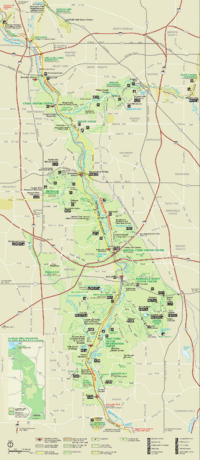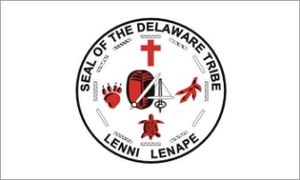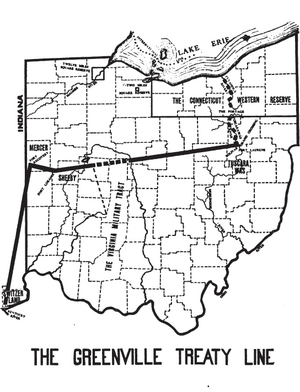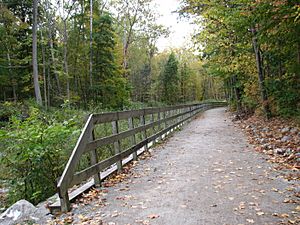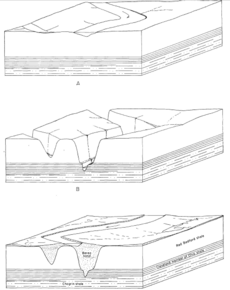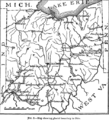Cuyahoga Valley National Park facts for kids
Quick facts for kids Cuyahoga Valley National Park |
|
|---|---|
|
IUCN Category II (National Park)
|
|

Bedrock outcrops, such as this one, can be found throughout the park
|
|
| Location | Summit County & Cuyahoga County, Ohio, United States |
| Nearest city | Cleveland, Akron |
| Area | 32,572 acres (50.9 sq mi; 131.8 km2) |
| Established | October 11, 2000 |
| Visitors | 2,096,053 (in 2018) |
| Governing body | National Park Service |
| Website | Cuyahoga Valley National Park |
Cuyahoga Valley National Park is a special place in America. It protects and brings back the natural beauty along the Cuyahoga River in Northeast Ohio. This park is located between the cities of Akron and Cleveland.
The park covers about 32,572-acre (50.9 sq mi; 131.8 km2) of land. It is managed by the National Park Service. But inside the park, you'll also find areas run by county parks or private businesses. Cuyahoga Valley started as a National Recreation Area in 1974. It became a full national park 26 years later in 2000. It's the only national park that began this way!
Cuyahoga Valley is Ohio's only national park. It's also one of three national parks in the Great Lakes Basin. The others are Isle Royale National Park in Lake Superior and Indiana Dunes National Park near Lake Michigan. What makes Cuyahoga Valley different is that it's right next to two big cities. It also has many roads, small towns, and other parks within its borders.
Contents
Park History
Early People of the Valley
Long ago, Native American tribes lived in the Cuyahoga Valley. The Lenapé Nation (also called the Delaware Nation) were very important here. They were known as "the Grandfathers" by many other Native Nations in the Ohio River Valley.
The Lenapé had a fair way of making decisions. Leaders would talk with elders who spoke for the people. They were skilled at trading and making things like pottery, tools, clothes, and baskets. Over time, wars and treaties forced the Lenapé to move away from their original lands. They moved west and south, eventually settling mostly in Oklahoma and Ontario, Canada.
How Native Americans Used the Land
The land was very important to the Lenapé. They believed it was sacred and alive. They called Earth "Kukna," meaning "our mother." They didn't think they owned the land, but rather that they belonged to it.
They used the land for hunting and farming. Corn, squash, and beans (called the three sisters) were their main foods. They also gathered fruits, nuts, and roots. Women did most of the farming, which provided most of their food.
The fur trade with Europeans changed their hunting. They started hunting more for furs than for their own needs. This caused animal populations, like beavers, to drop. It also made them rely more on European goods.
Waterways were key for trade. The Portage Path was a famous trail in modern-day Summit County. It connected the Cuyahoga and Tuscarawas Rivers. Native Americans used it to carry their canoes overland. This path allowed them to travel by water from the Great Lakes all the way to the Gulf of Mexico!
Native American Beliefs
The land of the Cuyahoga Valley was also important for Lenapé religious practices. They believed that spirits, called manitou, lived in nature. These spirits would guide young Lenapé people.
The Big House Ceremony, or Gamwing, was a very important event. It lasted twelve days. During this time, different Lenapé clans would come together. They would renew their connection to creation and their spiritual world. This ceremony helped the Lenapé keep their culture strong, even when they were forced to move.
Treaties and Land Loss
The Lenapé Nation no longer lives in the Cuyahoga Valley because of treaties and conflicts. In 1805, a treaty took away 500,000 acres (200,000 ha) of land, including the park area. This treaty promised money to the Native Nations who lost land, but the promise to let them keep hunting was not kept. Other treaties also took Lenapé land without their full agreement.
Today, the Lenapé Nation is mostly in Oklahoma. But there are also groups in Kansas, Wisconsin, Ontario (Canada), and even back in their original homelands like Pennsylvania and New Jersey.
How the Park Grew
In the 1870s, people from nearby cities started visiting the valley for fun. They would take carriage rides or boat trips on the canal. In 1880, the Valley Railway offered another way to escape city life.
Real park development began in the 1910s and 1920s. In the 1930s, the Civilian Conservation Corps (CCC) helped build many park structures. These included the Happy Days Lodge and shelters at the Ledges and Kendall Lake. The Happy Days Lodge was built as a camp for city kids.
By the 1960s, people worried that cities were growing too fast and would ruin the valley's beauty. The Cuyahoga River also had pollution problems, even catching fire in 1952 and 1969! Citizens worked with the government to find a solution.
On December 27, 1974, President Gerald Ford created the Cuyahoga Valley National Recreation Area. Even though some thought it wasn't special enough, it was a big step.
The National Park Service Takes Over
In 1985, the National Park Service bought the 47-acre (0.1 sq mi; 0.2 km2) Krejci Dump to add to the park. They found very toxic materials there. The area was closed in 1986 and cleaned up over many years.
On October 11, 2000, the area officially became a national park! The National Park Service manages it. The Richfield Coliseum, a large arena, was torn down in 1999. That land is now part of the park and is a great spot for birdwatching.
Park Wildlife
Cuyahoga Valley National Park is home to many animals! You might see raccoons, muskrats, coyotes, skunks, and red foxes. There are also beavers, peregrine falcons, river otters, and bald eagles. Other animals include opossums, moles, white-tailed deer, Canada geese, gray foxes, minks, great blue herons, and seven kinds of bats.
Park Climate
The park has a climate with hot summers. The coldest temperature recorded was about −23.3 °F (−30.7 °C). The hottest was about 101.7 °F (38.7 °C). The park gets about 38.42 inches (97.6 cm) of rain each year.
What to See and Do
Cuyahoga Valley National Park has many things to see and do. It has natural areas, man-made attractions, and even private businesses, which is unique for a national park.
The park has beautiful forests, rolling hills, deep ravines, wetlands, rivers, and waterfalls. There are about 100 waterfalls! The most famous is Brandywine Falls, which is 65-foot (20 m) tall. The Ledges are cool rock formations where you can see great views. You can also find small caves among the rocks.
The park has many trails. The most popular is the 20-mile (32 km) Towpath Trail. It follows an old part of the Ohio and Erie Canal. It's great for hiking, biking, and running. In winter, you can go skiing or sledding at Kendall Hills. You can also play golf or take a fun train ride on the Cuyahoga Valley Scenic Railroad.
The park also shows how people lived and farmed in the 1800s and early 1900s. The Hale Farm and Village is a great example. You can also enjoy art shows, outdoor concerts, and theater performances.
Ohio and Erie Canal Towpath Trail
The Ohio and Erie Canal Towpath Trail is a main trail in the park. It's almost 21 mi (34 km) long. It follows the Cuyahoga River for most of its way. You can find restrooms, food, and drinks along the trail. There are also three visitor centers: the Canal Exploration Center, Boston Store, and the Hunt House.
The trail connects to other trails outside the park. You can ride for almost 70 mi (110 km) continuously! The trail also meets the Buckeye Trail inside the park.
You can also ride the Cuyahoga Valley Scenic Railroad along the towpath. You can get on or off at different stops. The train is popular for bikers and for seeing the beautiful fall colors.
History of the Towpath
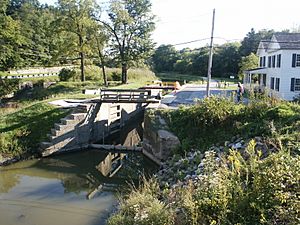
The Towpath Trail follows the old route of the Ohio and Erie Canal. This canal was built between 1825 and 1832. It helped connect Ohio to the rest of the eastern United States. Before the canal, it was hard to travel and sell crops.
Today, you can walk or ride where mules used to pull canal boats. The canal used to be full of water and boats. You can still see signs of beavers along the trail today!
Stanford House
The Stanford House is a historic farm home built in the 1830s. It was one of the first homes in the Western Reserve area. Today, it's a place where groups can meet or stay overnight. It has nine bedrooms and is a great place for visitors to stay inside the park.
Towpath Trailheads
You can find parking for the towpath trail at many spots. Here are some of them:
- Lock 39 (near Rockside Road)
- Canal Exploration Center (at Hillside Road)
- Frazee House (south of Alexander Road)
- Station Road Bridge (east of Chippewa Creek Drive)
- Red Lock (east of the river)
- Boston Store (east on Boston Mills Road)
- Peninsula Depot (in Peninsula)
- Lock 28 (south of Major Road)
- Hunt House (at Bolanz Road)
- Ira Road (just north of intersection)
- Botzum station (south of Bath Road)
Park Geology
The Cuyahoga River makes a strange "V" shape. It flows southwest, then suddenly turns north to empty into Lake Erie. The northern part of the "V" follows an old valley from before the ice ages. The southern part is a newer path.
Many waterfalls in the park, like Brandywine Falls, formed as water wore away softer rock layers. The harder rock above creates the waterfall.
The valley is filled with about 400 feet (120 m) of material left behind by glaciers. You can also see old beach deposits from ancient lakes that existed after the glaciers melted.
The Berea Sandstone and Bedford Shale rocks were formed in a river delta long ago. These rocks have been used for building and for grinding stones. The Sharon Conglomerate forms the highest hills and rocky ledges, like the Boston Ledges. These rocks are very strong and resist erosion. As softer rock underneath washes away, huge blocks of the Sharon Conglomerate break off, creating cracks and small caves.
People have found natural gas in the area since 1883. There are huge amounts of oil and gas in the deep shales under the park.
Visitor Centers
- The Canal Exploration Center is in Valley View. It has maps and games about the canal's history. It's in an old canal-era building that used to be a tavern.
- Boston Store was built in 1836. It was a warehouse, store, and post office. Today, it's a museum about building canal boats. You can also get maps and brochures here.
- The Hunt House shows what a family farm looked like in the late 1800s. You can learn about the area's farming history here. It's a great place to start a hike or bike ride.
- The Frazee House was built around 1825, when the canal was being dug. It's a good example of a Western Reserve style home. It has exhibits about old building styles and the Frazee family.
Historic Places to Visit
| Site | Image | What You Can See |
|---|---|---|
| Canal Exploration Center |
 |
Learn about the Ohio and Erie Canal here. The center is in an old tavern building. Lock 38 is right outside. |
| Ohio and Erie Canal Structures |
 |
See parts of the old Ohio and Erie Canal, built in the 1800s. You can find old locks and ruins along the Towpath Trail. |
| Frazee House |  |
This house was built in 1825. It's a good example of the Western Reserve style. |
| Boston Store (Boston Mill Visitor Center) |  |
This old building was a store and warehouse. It has exhibits about how canal boats were built. |
| Peninsula Depot |  |
This train station is in Peninsula. It's an active stop for the Cuyahoga Valley Scenic Railroad train rides. |
| Everett Covered Bridge |  |
This is the only covered bridge in Summit County. It was rebuilt in 1986 after a flood destroyed the original. |
| Brandywine Village |  |
See what's left of this old village. It grew around a sawmill built near Brandywine Falls in 1814. |
| Civilian Conservation Corps Buildings |  |
The Civilian Conservation Corps built several structures in the 1930s. These include Happy Days Lodge and shelters at the Ledges and Kendall Lake. |
| Stanford House |  |
This beautiful Greek Revival home was built around 1830. It's now a place for meetings and overnight stays. |
| Hale Farm and Village |  |
This is an outdoor museum where people in costumes show what life was like long ago. You can see old buildings and watch craftspeople at work. |
Images for kids
See also
 In Spanish: Parque nacional Valle Cuyahoga para niños
In Spanish: Parque nacional Valle Cuyahoga para niños




